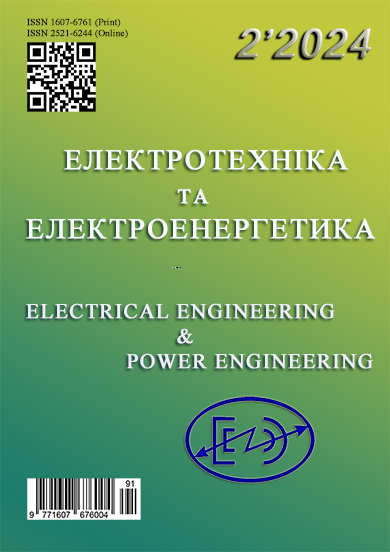Study of unbalance voltage in three-phase networks with different neutral modes
DOI:
https://doi.org/10.15588/1607-6761-2024-2-3Keywords:
voltage, zero sequence, asymmetry, isolated neutral, compensated neutral, network with a resistor in the neutralAbstract
Purpose. Determination of the influence of network parameters with different neutral modes on the zero-sequence voltage
Methodology. The research methodology is based on the general theory of electrical engineering and, in particular, on the method of symmetrical components.
Findings. A mathematical model has been developed to establish the nature of the zero-sequence voltage change for different modes of the network neutral. The value of the zero-sequence voltages and the angles between the phase voltage vector with asymmetry and the zero-sequence voltage vector depending on the capacitive asymmetry, capacitance and active resistance of the network insulation for different neutral modes are established.
Originality. Conducted studies have shown that the largest increase in the zero-sequence voltage is observed at the asymmetry capacity, which is 10...30% of the network insulation capacity. Moreover, the relative capacitive asymmetry of the insulation when changing the values of the capacitance of the network relative to the ground has the most significant effect on the value of the zero-sequence voltage in networks with a compensated neutral and is practically excluded when the neutral of the network is completely isolated relative to the ground.
Practical value. For real parameters of the network, based on the results of theoretical and experimental studies, it is possible to judge the efficiency of existing protection devices and use them in the development of new principles and protection devices.
References
Pravyla ulashtuvannja elektroustanovok. (2017). Ky-iv. Minenergovugillja Ukrai'ny, 617.
Nikander, A.; Järventausta, P. (2017). Identification of High-Impedance Earth Faults in Neutral Isolated or Compensated MV Networks. IEEE Trans. Power De-liv., 32, 1187–1195. https://ieeexplore.ieee.org/document/7809183.
Gana, N., Ab Aziz, N. F., Ali, Z., Hashim, H. and Yunus, B. (2017). ‘A comprehensive review of fault location methods for distribution power system’, In-dones. J. Electr. Eng. Comput. Sci., 6, 1, 185–192. https://doi.org/10.11591/ijeecs.v6.i1.pp185-192.
Karpov, Ju.O., Kacyv, S.Sh., Kuharchuk, V.V., Ved-mic'kyj, Ju.G.; pid red. prof. Karpova, Ju.O. (2011). Teoretychni osnovy elektrotehniky. Ustaleni re-zhymy linijnyh elektrychnyh kil iz zoseredzhenymy ta rozpodilenymy parametramy: pidruchnyk. Vin-nycja: VNTU, 377.
Spinul, L.Ju., Buryk, M.P., Lobodzyns'kyj, V.Ju., Bilec'kyj, O.O. (2022). Teoretychni osnovy el-ektrotehniky Chastyna 2: Navchal'nyj posibnyk [El-ektronnyj resurs, KPI im. Igorja Sikors'kogo. – El-ektronni tekstovi danni (1 fajl: 9 Mbajt). Kyiv: KPI im. Igorja Sikors'kogo, 167.
Fan, Y., Guang, L., Yu, S., Yongduan, X., Hui, P., Bin-gyin, X. (2019). Electrical Characteristics of Medium-voltage Distribution Network with Single-phase-to-ground Fault After Arc Extinction. Autom. Electr. Power Syst., 43, 134. https://doi.org/10.7500/AEPS20180911007.
Farughian, A., Kumpulainen, L. and Kauhaniemi, K. (2018). ‘Review of methodologies for earth fault in-dication and location in compensated and unearthed MV distribution networks’, Electr. Power Syst. Res., 154, 373–380. , https://doi.org/10.1016/j.epsr.2017.09.006.
Willheim, R., Waters, M. (1956). “Neutral Grounding in High Voltage Transmission”. Elsevier publishing company, New York.
Petteri Kangasluoma. (2019). Medium Voltage Net-work Residual Earth Fault Current Estimation Meth-ods / Master of Science Thesis. Tampere University. Master’s Degree Programme in Electrical Engineering. November, 97. https://urn.fi/URN:NBN:fi:tuni-201911155985.
Abbas, A. K., Hamad, S. and Hamad, N. A. (2021). ‘Single line to ground fault detection and location in medium voltage distribution system network based on neural network’, 23, 2, 621–632. https://doi.org/10.11591/ijeecs.v23. i2.pp621-632.
Altonen, J.; Wahlroos, A.; Vähäkuopus, S.; Oy, E. (2017). Application of multi-frequency admittance-based fault passage indication in practical compen-sated MV-network. CIRED 2017, 947–951. https://doi.org/10.1049/oap-cired.2017.0967.
Farughian, A.; Kumpulainen, L.; Kauhaniemi, K. (2019). Earth Fault Location Using Negative Se-quence Currents. Energies, 12, 3759. https://doi.org/10.3390/en12193759.
Gururajapathy, S. S., Mokhlis, H. and Illias, H. A. (2017). ‘Fault location and detection techniques in power distribution systems with distributed genera-tion: A review’, Renew. Sustain. Energy Rev., 74, March, 949–958. https://doi.org/10.1016/j.rser.2017.03.021.
Authafa, S. (2018). ‘Short Circuit Faults Identifica-tion and Localization in IEEE 34 Nodes Distribution Feeder Based on the Theory of Wavelets’, Iraqi J. Electr. Electron. Eng., 14, 1, 65–79. https://doi.org/10.37917/ijeee.14.1.7.
Farughian, A, Kumpulainen, L, Kauhaniemi, K. (2020). Non-Directional Earth Fault Passage Indica-tion in Isolated Neutral Distribution Networks. Ener-gies., 13(18), 4732. https://doi.org/10.3390/en13184732.
Stojanović, Z.N.; Djurić, M.B. (2013). An algorithm for directional earth-fault relay with no voltage in-puts. Electr. Power Syst. Res., 96, 144–149. https://doi.org/10.1016/j.epsr.2012. 11.004.
Baù, M., Benato, R., Dambone Sessa, S., Poli, M. and Quaciari, C. (2016) ‘Phase-to-ground fault location methods in unearthed sub-transmission networks: A review’, AEIT 2016 - Int. Annu. Conf. Sustain. Dev. Mediterr. Area, Energy ICT Networks Futur., , https://doi.org/10.23919/AEIT.2016.7892761.
Papai'ka, Ju.A., Lysenko, O.G., Rogoza, M.V., Tokar, L.O., Stepanenko, Ju.V. (2019). Vtraty energii' v el-ektroobladnanni pry nyz'kij jakosti naprugy. Visnyk KrNU imeni Myhajla Ostrograds'kogo, 1, 114, 9¬–13.
Downloads
Published
How to Cite
Issue
Section
License
Copyright (c) 2024 Y.V. Stepanenko

This work is licensed under a Creative Commons Attribution-ShareAlike 4.0 International License.
Creative Commons Licensing Notifications in the Copyright Notices
Authors who publish with this journal agree to the following terms:
Authors retain copyright and grant the journal right of first publication with the work simultaneously licensed under aCreative Commons Attribution License that allows others to share the work with an acknowledgement of the work's authorship and initial publication in this journal.
Authors are able to enter into separate, additional contractual arrangements for the non-exclusive distribution of the journal's published version of the work (e.g., post it to an institutional repository or publish it in a book), with an acknowledgement of its initial publication in this journal.
Authors are permitted and encouraged to post their work online (e.g., in institutional repositories or on their website) prior to and during the submission process, as it can lead to productive exchanges, as well as earlier and greater citation of published work.

